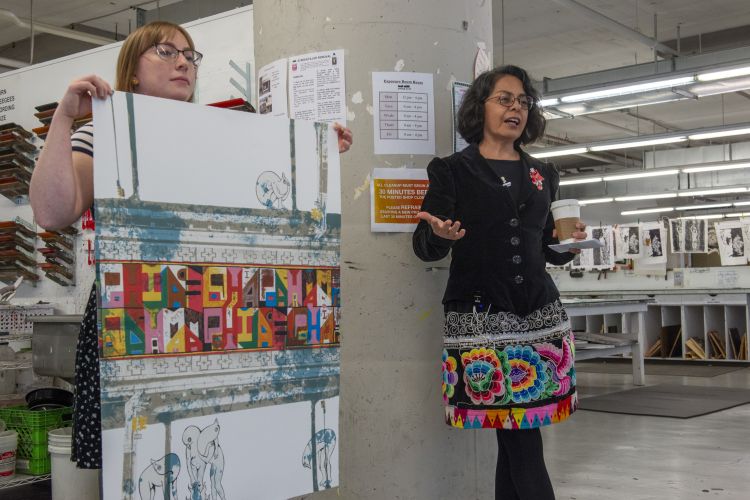STORIES FROM PAFA
An Interview with Belle Kim about her work in "Once Upon a Place" International Student Exhibition
By Marley Massey Parsons (MFA) on February 17th, 2022, originally featured in Career Services student newsletter
Could you tell us a little about your work in the Once Upon a Place exhibition?
I grew up in the city of Seoul, Korea. Living in Philadelphia, I often think of Seoul, where I once lived on the other side of the planet. Cities seem weird, the buildings stand tall and proud, asking to be seen, yet I have never had the impression that they welcomed me. To me, the city is just a shell, an illusion. They are like clothes worn by other people that I see walking the city streets. No one really knows what awaits inside. The buildings feel secluded and secretive as if I am just a stranger who does not belong to them. Why do the pigeons that I see while walking through this city look so similar to those in Seoul? It’s because they no longer migrate and are now considered domesticated as if the city buildings have separated them from nature. In my mind, the beautiful city buildings and their inhabitants became urban illusions, the same illusions I grew up with in Seoul. It makes me think a lot about where I am in this illusion.
How would you describe your experience planning and installing your work in the museum gallery?
When creating my project in my studio, I didn't initially plan for a full installation. Planning my work has always been a unique one of a kind experience. Every object I create is handmade and one of a kind. I enjoy losing myself in the process and letting my imagination drive my hands to creation. For the process, I collected leftover pieces of fabric and sewed them together, then connected them all with zippers. Looking out of my studio, viewing the city buildings, I realized I was creating exactly what I was seeing in my mind; it was a city building. I then created my silkscreen pigeons with the same face, cloned them, and ended up with 50 fabric pigeons. Still feeling the pigeons (they are everywhere), I bought rubber and created a pigeon mold; from there, I created an additional 20 cement pigeons. Once I felt I had enough to start assembly, I viewed everything together yet individually, let my mind free, and began again to tie all of the pieces together to create a story. Clothes and zippers are perfect materials for my use as each, in a sense, has two different characteristics - the clothes are like building walls, windows and doors, whereas zippers connect, close, and or open these walls, windows and doors. Initially, I didn't think about creating the entire story, it just happened naturally. Since it was pre-installed in an empty studio, installing it in the museum gallery was not difficult. It was much easier to create my installation in the museum since it has a ceiling I can use to mount various objects, helping to create a broader, deeper view.
What was it like to see your work outside of your studio? Did you discover or learn anything?
The first installation I initially started in my studio, in my mind, was going to create a huge city scene. However, as I worked on the project inside my studio, it started taking the form of a closed box or an alley with a dead end. The four studio walls gave it a bleak image from which it felt as if there was no escape. That made the city installation image more desperate. However, when it was re-installed in the museum gallery, it had a completely different feeling because there were columns in the room, which really opened up the space. The space was also much larger, so the fabric city pieces seemed smaller. I found that the images almost changed perspective when installed in the museum. I enjoyed the open space and the feeling that I determined each object and every position. I learned that the overall image of the installation can change depending on the size and atmosphere of the space. I really enjoyed the installation work, found it exciting, and have been inspired to build upon my past installations.
Does your work in Once Upon a Place relate to your ideas for the Annual Student Exhibition (ASE)?
The city where countless people, animals, objects, future, present, past intersect is the subject of my work and one that I have found myself deeply interested in. This form of installation art allows me to express my own point of view about the city and its coexistence with nature, people, time, and materials. I am able to express how I view time passing and intersecting and how the animals that were the original owners of the city are now living under the protection of us humans. My installation art creates various and numerous angles depending on the physical characteristics of the room, lighting, and size of objects placed at different angles. The viewer is able to see different perspectives of my city depending on their position in the room. Learning this process has given me a lot to think about, and I have had a lot of fun along the way! In this regard, I will extend my current installation and plan with ASE my next project called, ‘Time to Connect’.
We're so excited you're planning to visit PAFA!
Make time for art — visit us Thursday to Sunday.
Before reserving your tickets, please review helpful information about museum hours, accessibility, building access, and special admission programs.
If you have any questions, feel free to reach out to us at visitorservices@pafa.org — we’d love to help!



